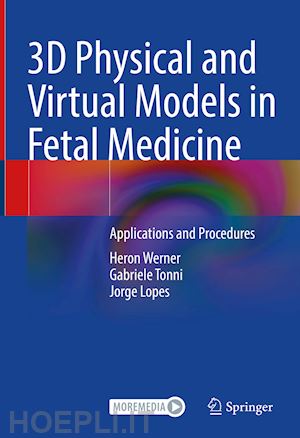
Questo prodotto usufruisce delle SPEDIZIONI GRATIS
selezionando l'opzione Corriere Veloce in fase di ordine.
Pagabile anche con Carta della cultura giovani e del merito, 18App Bonus Cultura e Carta del Docente
Technological innovations accompanying advances in medicine have given rise to the possibility of obtaining better-defined fetal images that assist in medical diagnosis and contribute toward genetic counseling offered to parents during the prenatal care. 3D printing is an emerging technique with a variety of medical applications such as surgical planning, biomedical research and medical education.
Clinical Relevance: 3D physical and virtual models from ultrasound and magnetic resonance imaging have been used for educational, multidisciplinary discussion and plan therapeutic approaches.
The authors describe techniques that can be applied at different stages of pregnancy and constitute an innovative contribution to research on fetal abnormalities. We will show that physical models in fetal medicine can help in the tactile and interactive study of complex abnormalities in multiple disciplines. They may also be useful for prospective parents because a 3D physical modelwith the characteristics of the fetus should allow a more direct emotional connection to their unborn child.
Heron Werner Jr, PhD, MD, graduated in Obstetrics and Gynecology at the University of Rio de Janeiro. He is currently Consultant in Maternal-Fetal Medicine at Clínica de Diagnóstico por Imagem (CDPI), Rio de Janeiro, Brazil. In the early 1990s, “Medecin Étranger, Université de Paris V” under the guidance of Professor Fernand Daffos and Jacques Chavinié. Master in Obstetrics and PhD in Radiolgy at the Federal University of Rio de Janeiro. Visiting Professor at The Children’s Hospital of Philadelphia. Author of the books “Magnetic Resonance in Obstetrics and Gynecology”; “3D Technologies – Paleonthology, Archaeology- Fetology” and “3D Technologies – Unveiling the past, shaping the future”. Author of many articles related to 3D printing in fetal medicine and virtual reality.
Prof. Gabriele Tonni, PhD, MD, graduated Magna cum Laude in Obstetrics and Gynecology at the University of Parma. He is currently Consultant in Maternal-Fetal Medicine at Azienda Sanitaria Locale, Reggio Emilia, Italy. In the early 1990s, he has carried out research in the field of perinatal medicine investigating the role of intrapartum asphyxia and perinatal brain damage under the guidance of Professor James A. Low at the Queen’s University in Kingston, Canada. After gaining work experience in the United Kingdom, where he was granted RCOG certification in minimally invasive gynecologic surgery, he started to practice prenatal ultrasound diagnosis. He was trained in fetal invasive procedure at Nottingham City Hospital, under the guidance of Professor David T. Liu. He holds the Diploma in Fetal Medicine, the highest degree awarded by the Fetal Medicine Foundation, London. He has produced a PhD thesis on first trimester screening for fetal aneuploidy at University “La Sapienza” in Rome in 2000, the first publication on this clinical issue in Italy. Dr. Gabriele Tonni has been devoted to develop applications for 3D ultrasound and fetal MRI in the antenataldetection of congenital anomalies, particularly to the study of fetal palate and orofacial malformations, in which he gained worldwide expertise. He has developed outstanding international collaborations and is currently involved in the applications of 3D virtual physical models of fetal abnormalities using 3D ultrasound volume and fetal MRI scan data. He has contributed to more than 100 publications in peer-reviewed journals and serves as reviewer to more than 40 international journals. He has been invited to attend many national and international congresses where he acted as chairman or lecturer and has attended the Fetal Medicine Center, Hospital Clinic, Barcelona University
Jorge Lopes dos Santos, PhD, is a designer specialist in 3D printing. He is a professor at PUC Rio, a university in Brazil reference in the design field. Inside his lab at the university, he develops works that involve trends in areas such as medicine, architecture, paleontology,among others. He is also a researcher at the National Institute of Technology and the National Museum, leading the recreation of part of the collection lost in a tragic fire, using additive manufacturing and the ashes themselves. Its trajectory reconciles arts and engineering, reinforcing the importance of dialogue between different areas of knowledge. Postgraduate Professor - Department of Arts and Design - PUC Rio. Coordinator of the Three-Dimensional Development Center - DAD - PUC Rio. Collaborating Researcher at the National Museum of UFRJ (Digital Image Processing Laboratory). Collaborating Researcher at the Museum of Tomorrow. He has developed a way of making physical models of foetuses using data from ultrasound, CT and MRI scans.











Il sito utilizza cookie ed altri strumenti di tracciamento che raccolgono informazioni dal dispositivo dell’utente. Oltre ai cookie tecnici ed analitici aggregati, strettamente necessari per il funzionamento di questo sito web, previo consenso dell’utente possono essere installati cookie di profilazione e marketing e cookie dei social media. Cliccando su “Accetto tutti i cookie” saranno attivate tutte le categorie di cookie. Per accettare solo deterninate categorie di cookie, cliccare invece su “Impostazioni cookie”. Chiudendo il banner o continuando a navigare saranno installati solo cookie tecnici. Per maggiori dettagli, consultare la Cookie Policy.